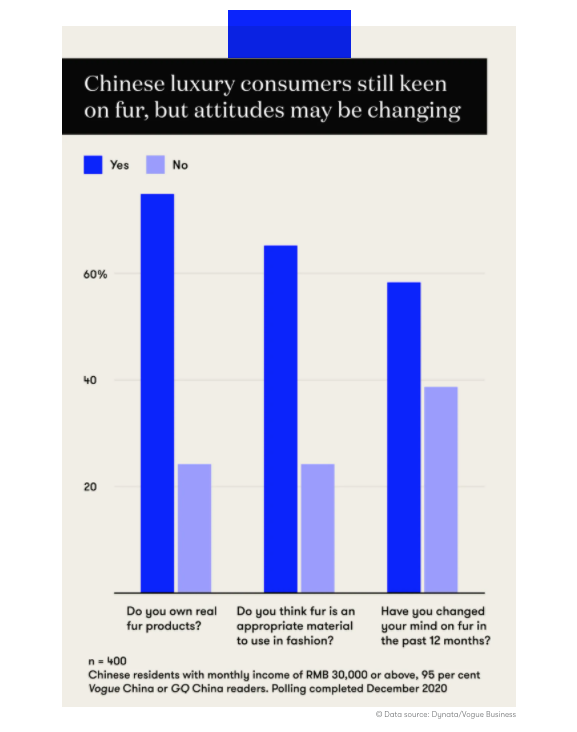According to Vogue Business, “For those luxury brands that are continuing to use fur, the focus is on China, the country most important to the $22 billion worldwide fur trade. A survey of 400 high-income Chinese residents, predominantly Vogue and GQ readers, by Vogue Business and market research group Dynata, shows that demand for fur in China is likely to remain robust for now”
Vogue Business state, “Falling prices for European fur may be to the benefit of companies targeting the Chinese market. Sofya Bakhta, China market analyst at Daxue Consulting, says that 2019 saw Singles Day sales for fur top RMB 100 million, a 10 per cent rise on the year before. “[Fur coats] are often given as lavish gifts.”
Vogue Business go on to state how IFF’s certification and traceability program is the future, stating, “LVMH and Kering both recognise Furmark, a programme developed by the International Fur Federation (IFF) that brings animal welfare and sustainability certifications from Europe, the US, Canada, Russia and Namibia under one umbrella. Chinese farms are not yet included in the scheme.
Fur is still a pivotal material used by many high-fashion designers. Vogue share how, “Louis Vuitton CEO Michael Burke told Il Sole 24 Ore last autumn that the brand has no plans to abandon the use of fur or exotic skins, citing the ethical certifications the brand has in place on the farms it uses, the practicability of the materials and the centuries of craftsmanship utilising them. The continued support for fur by brands like Louis Vuitton remains important to the fur industry and its image to Chinese buyers, even if sales by luxury brands account for a small share of the overall retail trade in fur. Rein says he is doubtful that luxury consumers in China would care much whether they are buying real or faux fur, as long as the product is from a name they trust. “They care more about the luxury brand than they do about the actual ingredients,” he says.
In the West, there has been a link between Covid-19 and fur farming, particularly mink. Vogue Business explore this, stating, “The University of Helsinki and the Finnish Fur Breeders’ Association announced last Tuesday that work is advanced on a vaccine for mink and finn raccoon. Mark Oaten, CEO of IFF, says that the vaccine is a potential game changer that can help to unlock funds from lenders for farmers looking to expand their production to cover the drop in supply caused by the Danish cull. China consumers’ growing interest in environmental concerns, particularly among the young, represents a long-term challenge for the fur industry. But Oaten points out that fur is a plastic-free product that is more environmentally friendly than faux-fur alternatives. “Our challenge is to say, look, it is a luxury, but it’s also sustainable,” he argues. “It’s not something that you throw away every year. It is actually a natural product.”






